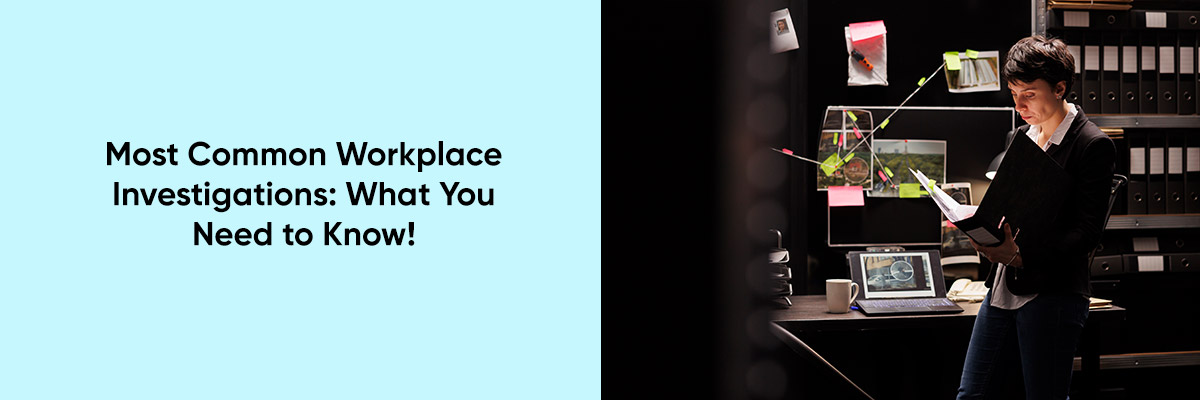A workplace is where a company’s key assets—its employees—perform their tasks to achieve common goals and drive the company forward. However, obstacles can sometimes arise that hinder progress towards these goals. To address and overcome these challenges, various workplace investigations are conducted to identify and resolve issues. While there are many hurdles in a company that may require different types of investigations, this blog will focus on the most common ones.
Whether you’re a seasoned HR manager or new to the field, understanding these common workplace investigations can be crucial. Similarly, if you’re an employee facing an issue that requires resolution, knowing the process can help you navigate it more effectively.



1. Harassment and Discrimination
These investigations focus on claims of workplace harassment or discrimination, which may be based on race, gender, age, religion, or disability.
Key Steps:
- Receive Complaints: Take all complaints seriously. For instance, if Kim reports feeling harassed by a colleague due to her gender, document her complaint thoroughly.
- Gather Evidence: Interview witnesses like John’s colleagues who may have observed the behavior, collect relevant documents such as emails, and review related communications.
- Ensure Fairness: Maintain confidentiality and avoid any retaliation against Kim or others involved in the investigation.
Example: Rita, an employee, reports feeling discriminated against by her team lead, Kim, who has made several derogatory remarks about her Hindu religion. The investigation focuses on interviewing both Rita and Kim, as well as their colleagues, and reviewing any related emails or communication to address the issue thoroughly.
2. Misconduct and Violations of Company Policy
This involves investigating behaviors that breach company policies, such as theft, substance abuse, or inappropriate behavior.
Key Steps:
- Identify the Issue: Clearly define the policy or rule that has allegedly been violated. For example, Brock is suspected of theft based on surveillance footage showing unusual activity.
- Collect Evidence: Review surveillance footage, employee records, and conduct interviews with Brock and any witnesses.
- Document Findings: Record all findings and actions taken during the investigation, such as Brock’s response and any evidence gathered.
Example: Brock is suspected of stealing office supplies. The investigation involves checking surveillance footage and interviewing Brock and his co-workers to determine the facts.
3. Fraud and Financial Irregularities
Investigations into suspected financial misconduct, including embezzlement, accounting fraud, or misuse of company funds.
Key Steps:
- Examine Financial Records: Analyze financial statements and transaction records. For instance, discrepancies in the accounts lead to an investigation.
- Conduct Interviews: Speak with employees involved in financial processes, such as the accounting team.
- Report Findings: Prepare a detailed report outlining the investigation’s outcome and recommendations for corrective action.
Example: Anomalies in financial records suggest potential embezzlement. The investigation includes examining financial documents and interviewing accounting staff to uncover any irregularities.
4. Safety and Health Violations
Investigations related to breaches of workplace safety regulations or health concerns, such as unsafe working conditions or exposure to hazardous materials.
Key Steps:
- Assess Compliance: Review safety protocols and investigate any reported incidents. For example, an employee reports unsafe working conditions in the warehouse.
- Inspect Facilities: Conduct physical inspections of the workplace to identify potential hazards.
- Implement Improvements: Recommend changes to improve safety and ensure compliance with regulations.
Example: An employee reports that the warehouse is not properly ventilated, leading to health concerns. The investigation involves inspecting the facilities and suggesting necessary improvements.
5. Employee Disputes and Conflicts
Investigations into interpersonal conflicts between employees or between employees and management.
Key Steps:
- Understand the Conflict: Gather information to understand the nature and scope of the dispute. For instance, Kim and John have ongoing conflicts affecting their work.
- Facilitate Mediation: Mediate discussions between conflicting parties to resolve issues amicably.
- Follow-Up: Monitor the resolution process to ensure that the conflict is effectively resolved and does not recur.
Example: Kim and John are having ongoing disputes that impact their work. The investigation involves mediation sessions to resolve the conflict and monitor the situation afterward.
Key Considerations for Effective Investigations
For Employees:
- Report Issues Promptly: If you face or witness issues, report them as soon as possible to ensure timely intervention.
- Cooperate Fully: Participate in investigations by providing honest and detailed information.
- Maintain Confidentiality: Respect the confidentiality of the investigation process to avoid unnecessary gossip or retaliation.
For HR Managers and Investigators:
- Ensure Fairness: Approach each investigation impartially and avoid biases.
- Document Everything: Keep detailed records of all aspects of the investigation, from initial reports to final outcomes.
- Respect Privacy: Handle all information with discretion to protect the privacy of all parties involved.
- Follow Legal Requirements: Adhere to legal and regulatory requirements to ensure the investigation is conducted appropriately and to mitigate legal risks.
The Importance of Conducting Effective and Proper Workplace Investigations
While these issues might initially seem common and relatively minor, they can have serious long-term consequences for a company. They affect key areas such as assets, employees, and finances—three crucial components for any company’s success. If not addressed promptly and effectively, these issues can lead to decreased employee productivity, higher turnover rates, loss of valuable assets, and financial losses. In the long run, unresolved problems in these areas can severely impact the overall health and sustainability of the company.
Conclusion
By understanding and effectively managing these common workplace investigations, you can help maintain a fair, safe, and productive work environment. Whether you’re handling a case or navigating an investigation as an employee, knowing these processes can ensure that issues are addressed appropriately and efficiently.


